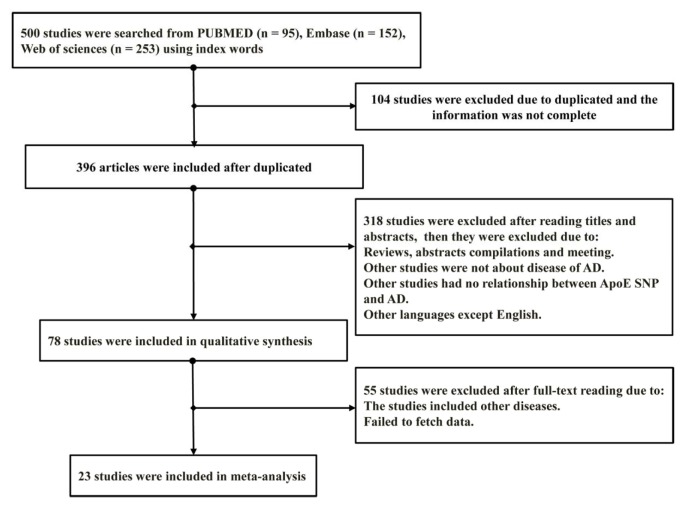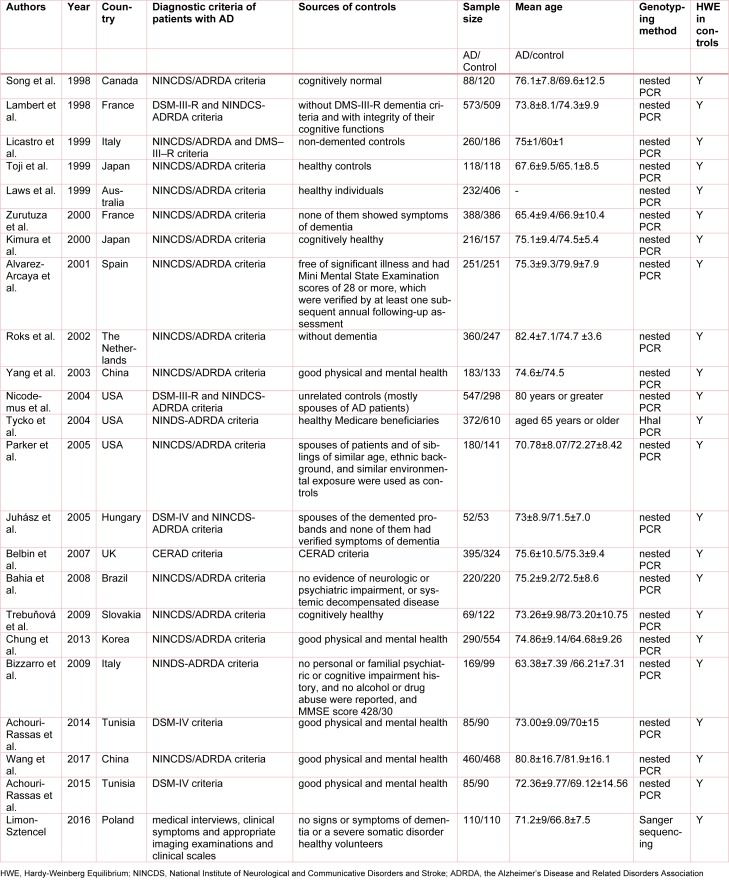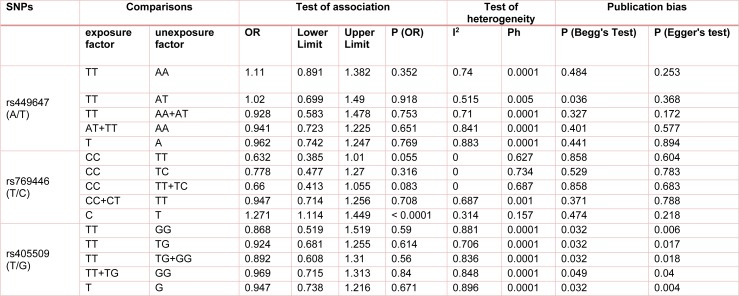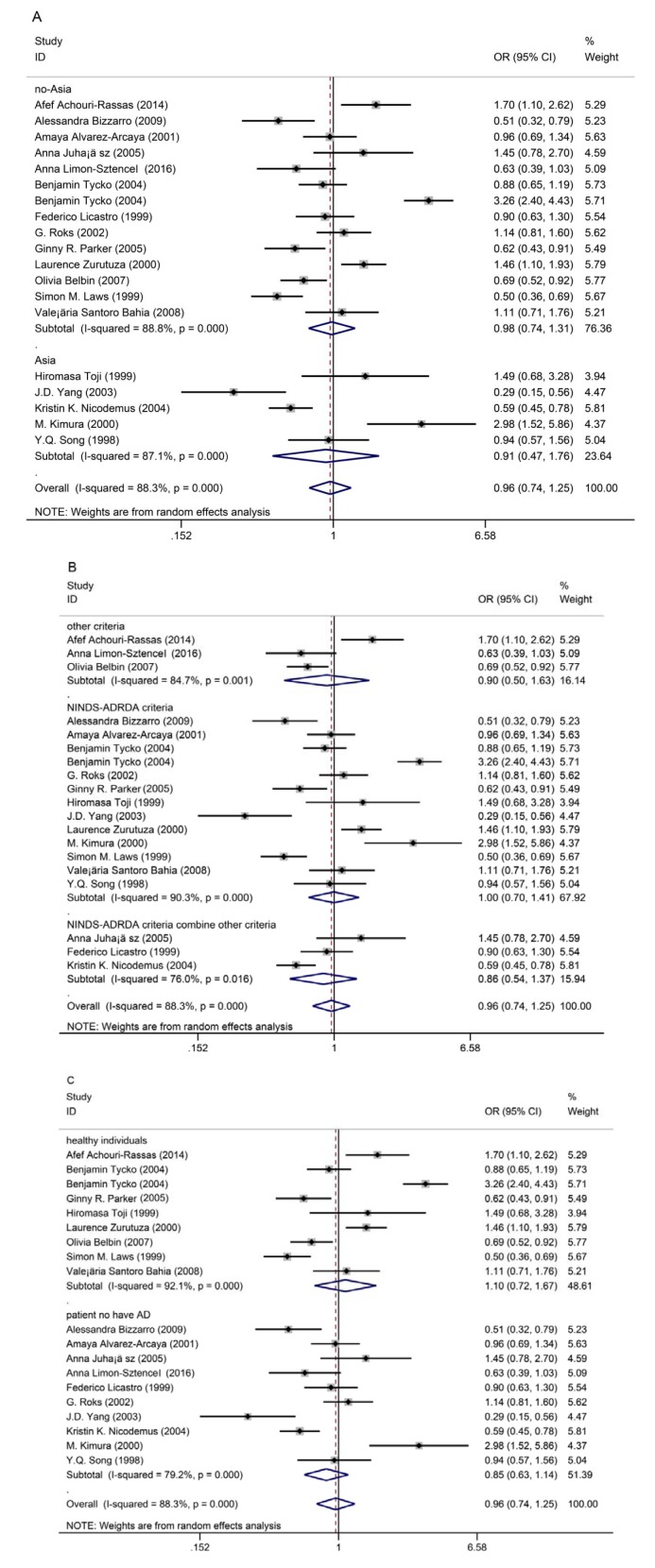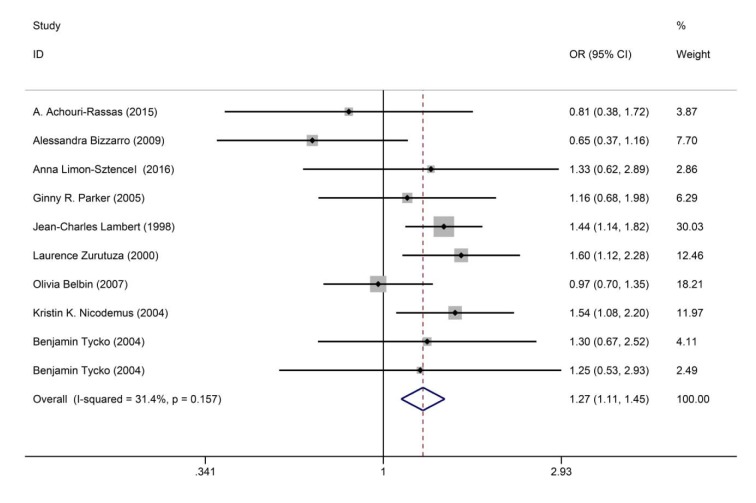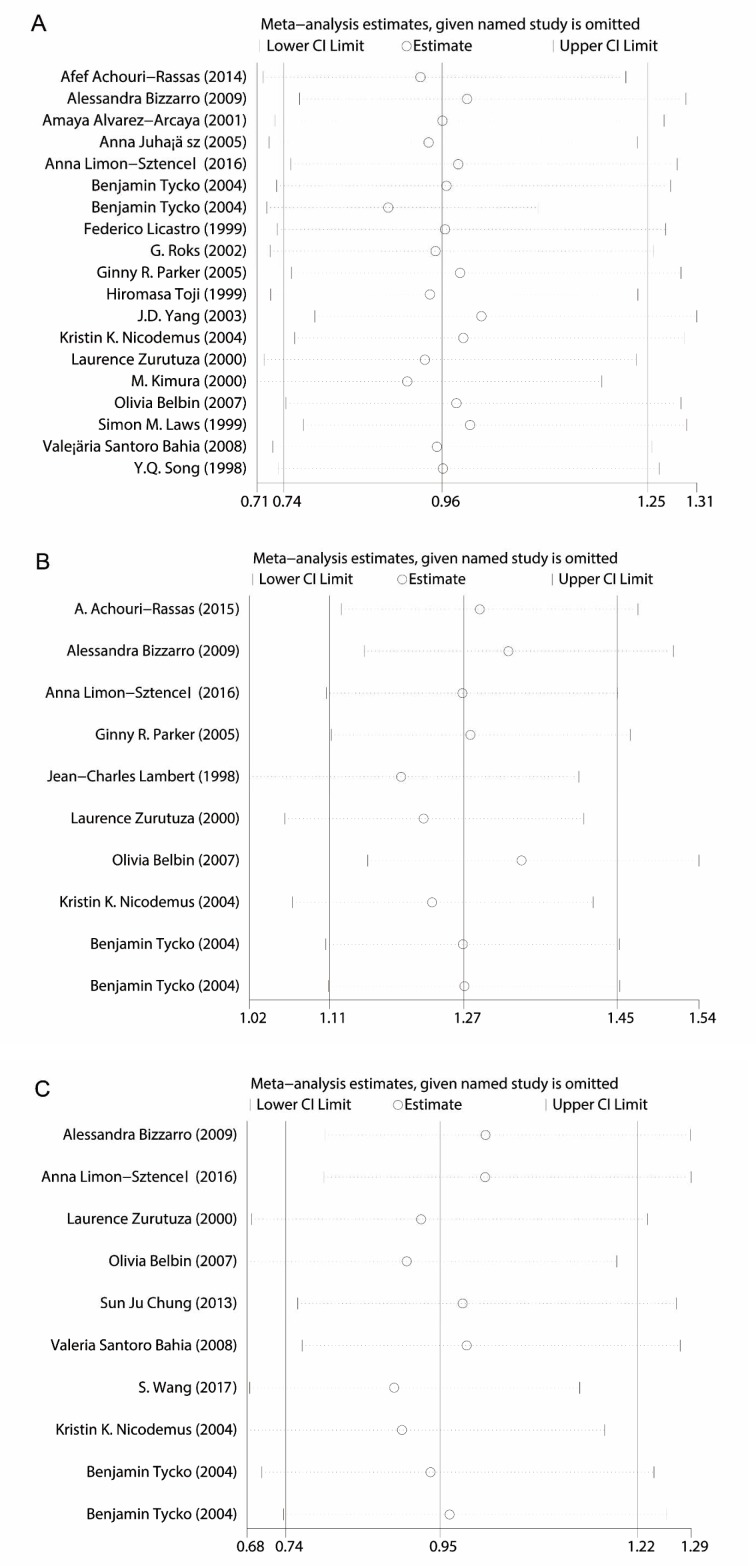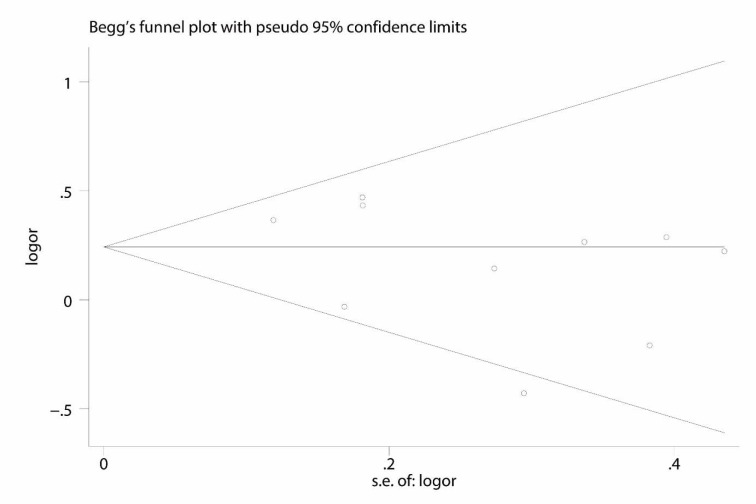Abstract
Several studies have evaluated the role of polymorphisms in the promoter region of APOE gene that encodes apolipoprotein E (APOE) and the susceptibility to Alzheimer's disease (AD). The aim of this literature review and meta-analysis was to investigate the relationship between the APOE promoter region single nucleotide polymorphisms (SNPs) (rs449647, -491A/T; rs769446, -427T/C and rs405509 -219T/G) and the risk of developing AD. Eligible controlled studies published up to November 2016 were retrieved from main online scientific and medical databases. Odds ratio (OR) and 95 % confidence interval (CI) were used to calculate the strength of the relationship. A total of 23 publications (19 for rs449647, ten for rs769446 and ten for rs405509) were retrieved that included 5,703 patients with AD and 5,692 controls. The C allele of the rs769446 variant of the promoter region of APOE gene was significantly associated with an increase of risk of AD (OR = 1.271, 95 % CI = 1.114-1.449, P < 0.0001), while other genetic models of this variant were not related with susceptibility to AD. Rs449647 and rs405509 polymorphisms of APOE gene were not associated with an increase of risk of AD. The findings of this literature review and meta-analysis have shown that rs769446 polymorphism in the promoter region of APOE gene could be a risk factor for AD. Future large-scale studies on the role of polymorphisms in the promoter region of APOE gene in AD are still awaited.
Keywords: Alzheimer's disease, apolipoprotein E, promoter region, polymorphism
Introduction
Alzheimer's disease (AD) is a chronic and progressive neurodegenerative disease that usually starts slowly and becomes more severe over time (Ballard et al., 2011[7]; Vinters, 2015[53]). Worldwide, AD is now the leading cause of dementia in late adult life, accounting for 60 % to 70 % of all cases of dementia (Mayeux and Stern, 2012[35]). The most common symptoms include cognitive impairment, loss of short-term memory, problems with language, disorientation, mood swings, loss of motivation, and behavioral issues (Geda et al., 2013[18]). According to the 2016 data from the Alzheimer's Association, an estimated 5.4 million Americans have AD, and approximately 700,000 Americans age ≥ 65 years will die with this disease in 2016 (Alzheimer's Association, 2016[4]). Furthermore, by 2050, one new case of Alzheimer's is expected to develop every 33 seconds, resulting in nearly 1 million new cases per year (Reitz and Mayeux, 2014[41]; Sosa-Ortiz et al., 2012[46]).
However, the etiology of AD remains unclear. Although there are now several drugs that can be used in the treatment of AD, randomized controlled clinical trials have yet to show robust treatment benefits (Gandy and Dekosky, 2013[16]). Also, the study of the long-term effect of any intervention for patients with AD is a great methodological challenge (Wimo, 2015[56]). Therefore, there is an urgent need to identify biomarkers that can predict this disease and guide therapeutic strategies.
AD is a heterogeneous disease, and about 70 % of the risk is believed to be genetic with many genes involved (Karch et al., 2014[24]). The APOE gene that encodes apolipoprotein E (ApoE) located on human chromosome 19 is a multifunctional protein and is a major cholesterol carrier with central roles in lipid metabolism, neurobiology, and neurodegenerative diseases (Carrasquillo et al., 2013[11]; Hatters et al., 2006[20]). The APOE gene has been recognized as a possible genetic risk factor for the onset of AD (Yu et al., 2014[60]). There are known to be three isoforms (ε2, ε3, and ε4) with different effects on lipid and neuronal homeostasis (Phillips 2014[39]). Epidemiologic studies have identified that these isoforms are the main genetic determinants of the progression of AD (Holtzman et al., 2012[21]). For example, individuals carrying the ε4 allele are at increased risk of AD when compared with those carrying the more common ε3 allele, whereas the ε2 allele decreases risk (Liu et al., 2013[33]). In addition to the polymorphism within the coding region, uncovering the polymorphisms within the APOE promoter region may also be beneficial to predict AD risk.
The APOE gene encodes apolipoprotein E (APOE) and has a promoter region that is complex, with several regulatory elements located in the proximal 5' flanking region and the first intron of the human APOE gene (Berg et al., 1995[9]; Garcia et al., 1996[17]). Thus, polymorphisms in this region could have functional repercussions mediated by the regulation of APOE gene transcription. Three single nucleotide polymorphisms (SNPs), at -491 (A/T, rs449647), -427 (T/C, rs769446) and -219 (T/G, rs405509) upstream from the +1 transcription start site have been identified. These SNPs might influence APOE transcriptional activity through differential binding of transcription factors (Sala Frigerio and De Strooper 2016[43]). Although several studies have estimated the effect of APOE gene variants in the promoter region on AD susceptibility, the results remain inconsistent. Therefore, we conducted a systematic review of the literature and meta-analysis to evaluate the current status of the association between polymorphisms in the promoter region of the APOE gene and the risk of AD.
Materials and Methods
Identification of eligible studies
A comprehensive literature search was conducted using the online databases of PubMed, Web of Science, Embase, Wanfang, and CNKI (China National Knowledge Infrastructure) to retrieve relevant articles published until November 2016. The Medical Subject Heading (MeSH) terms were: “Alzheimer's disease” or “Alzheimer” and “apolipoprotein E” or “APOE,” and “polymorphism” or “single nucleotide polymorphism” or “single nucleotide variant”.
The corresponding Chinese characters were used in the Chinese databases. References were manually checked to obtain more relevant articles. Studies written in English or in Chinese language were included. When the same authors or laboratories published more than one article that included the same study participants, only the most complete study was included into the meta-analysis.
Criteria for article screening
The eligible articles had to meet the following inclusion criteria: 1) case-control studies evaluating the relationship between polymorphisms in the promoter region of the APOE gene and susceptibility to Alzheimer's disease (AD); 2) diagnosis of patients with AD based on standards of the National Institute of Neurological and Communicative Disorders and Stroke (NINCDS) or Alzheimer's Disease and Related Disorders Association (ADRDA) working group (McKhann et al., 1984[36]); 3) inclusion of age-matched controls of unrelated participants without dementia; 4) results that were expressed as an odds ratio (OR) with corresponding 95 % confidence interval (95 % CI); and 5) distribution of the genotype of controls for each polymorphism were required to be in Hardy-Weinberg equilibrium (HWE).
The exclusion criteria were: 1) review article or conference papers; 2) studies without a control group; 3) studies with duplicated data; 4) inability to extract the study data; and 5) a study population that included patients with dementia due to causes other than AD.
Quality assessment and data extraction
Two authors independently assessed the quality of the extracted publications based on the study inclusion and exclusion criteria. Any disagreement was resolved by discussion with the third author, with each item discussed until a final consensus was reached. The following information was retrieved: name of the first author, publication year, country, mean patient age, number of cases and controls, distribution of genotypes, diagnostic criteria of AD, sources of controls, and genotyping methods.
Statistical analysis
Statistical analysis was carried out using the Stata 12.0 statistical software package (StataCorp, USA). The relationship between the APOE gene promoter polymorphisms and the risk of AD were evaluated by odds ratio (OR) with 95 % confidence interval (95 % CI). The significance of the pooled OR was determined by the Z-test. A P-value less than 0.05 was considered to be significant.
For each genetic variant, the allelic model, the homogeneous model, the heterogeneous model, the domain model, and the recessive model were calculated. Cochran's Q test and the I2 test were employed to evaluate the heterogeneity of the included articles. The fixed-effect model was used when the P-value of Cochran's Q test was more than 0.10, and I2 of the I2 test was less than 50 %; otherwise, the random-effect model was used. To assess whether our results were substantially influenced by the presence of any individual study, we conducted a sensitivity analysis by systematically omitting each study and recalculating the significance of the result. Egger's test and Begg's test were performed to examine the publication bias.
Results
Characteristics of eligible studies
We first identified 500 relevant publications on APOE gene polymorphisms and the risk of Alzheimer's disease (AD). However, after applying the study inclusion and exclusion criteria, a total of 23 publications were finally included for study and included 5,703 patients with AD, and 5,692 controls.
Figure 1(Fig. 1) shows the selection process of this meta-analysis. The 23 articles included studies that were conducted in 16 countries: three in USA (Nicodemus et al., 2004[37]; Parker et al., 2005[38]; Tycko et al., 2004[50]); two in China (Wang et al., 2017[55]; Yang et al., 2003[59]), two in Tunisia (Achouri-Rassas et al., 2014[2], 2015[1]), one in France (Verpillat, 2000[52]), two in Italy (Bizzarro et al., 2009[10]; Licastro et al., 1999[31]), two in Japan (Kimura et al., 2000[26]; Toji et al., 1999[48]), two in the UK (Belbin et al., 2007[8]; Lambert et al., 1998[27]), one in Canada (Song et al., 1998[45]), one in Australia (Laws et al., 1999[30]), one in Spain (Alvarez-Arcaya et al., 2001[3]), one in the Netherlands (Roks et al., 2002[42]), one in Hungary (Juhász et al., 2005[23]), one in Brazil (Bahia et al., 2008[6]), one in Slovakia (Trebuňová et al., 2009[49]), one in Korea (Chung et al., 2013[13]), and one in Poland (Limon-Sztencel, 2016[32]).
Figure 1. Flow chart of publication selection process in literature review and meta-analysis.
Three polymorphic sites in the promoter region of APOE gene were reported: rs449647 (-491A/T), rs769446 (-427T/C) and rs405509 (-219T/G). All specimens were from blood samples. The sample size ranged from 105 to 1082. The genotype distributions in the controls of all studies were in agreement with the Hardy-Weinberg equilibrium (HWE). The main characteristics of included studies are presented in Table 1(Tab. 1) (References in Table 1: Song et al., 1998[45]; Lambert et al., 1998[27]; Licastro et al., 1999[31]; Toji et al., 1999[48]; Laws et al., 1999[30]; Zurutuza et al.; 2000[61]; Kimura et al., 2000[26]; Alvarez-Arcaya et al., 2001[3]; Roks et al., 2002[42]; Yang et al., 2003[59]; Nicodemus et al., 2004[37]; Tycko et al., 2004[50]; Parker et al., 2005[38]; Juhász et al., 2005[23]; Belbin et al., 2007[8]; Bahia et al., 2008[6]; Trebuňová et al., 2009[49]; Chung et al., 2013[13]; Bizzarro et al., 2009[10]; Achouri-Rassas et al., 2014[2]; Wang et al., 2017[55]; Achouri-Rassas et al., 2015[1]; Limon-Sztencel, 2016[32]).
Table 1. Characteristics of the included studies and patient baseline demographics.
Association between rs449647 (-491A/T) APOE gene polymorphism and the risk of AD
There were 19 published studies that included the rs449647 (-491A/T) APOE gene polymorphism and the risk of AD. Between-study heterogeneity was found, and the random-effect model was employed to synthesize these data. Summary odds ratios (ORs) and tests for heterogeneity of published studies are shown in Table 2(Tab. 2).
Table 2. The pooled analysis between polymorphisms in the promoter region of APOE gene and risk of Alzheimer's disease (AD).
The T allele of rs449647 polymorphism was not associated with increased risk of AD when compared with the A allele (T vs. A: OR = 0.962, 95 % CI = 0.742-1.247, P = 0.769). This non-significant relationship was observed in other genetic models as well (TT vs. AA: OR = 1.11, 95 % CI = 0.891-1.382, P = 0.352; TT vs. AT: OR = 1.02, 95 % CI = 0.699-1.49, P = 0.918; AT+TT vs. AA: OR = 0.941, 95 % CI = 0.723-1.225, P = 0.651; TT vs. AA+AT: OR = 0.928, 95 % CI = 0.583-1.478, P = 0.753).
Subgroup analysis by ethnicity showed that there was a significant difference between Asian and non-Asian patients with AD and effects of rs449647 polymorphism and AD risk (P < 0.0001), as shown in Figure 2A(Fig. 2) (References in Figure 2: Achouri-Rassas et al., 2014[2]; Bizzarro et al., 2009[10]; Alvarez-Arcaya et al., 2001[3]; Juhász et al., 2005[23]; Limon-Sztencel, 2016[32]; Tycko et al., 2004[50]; Licastro et al., 1999[31]; Roks et al., 2002[42]; Parker et al., 2005[38]; Zurutuza et al., 2000[61]; Belbin et al., 2007[8]; Laws et al., 1999[30]; Bahia et al., 2008[6]; Toji et al., 1999[48]; Yang et al., 2003[59]; Nicodemus et al., 2004[37]; Kimura et al., 2000[26]; Song et al., 1998[45]).
Figure 2. Subgroup analysis of the association between rs449647 polymorphism and susceptibility to Alzheimer's disease (AD) .
A: ethnicity; B: diagnostic criteria of patients with AD; C: participants in the control groups
Subgroup analysis by diagnostic criteria for patients with AD showed that there was a significant difference for selection criteria in each study, as shown in Figure 2B(Fig. 2).
Subgroup analysis by participants in the control groups showed that there was a significant difference between healthy individuals and patients in the control groups, as shown in Figure 2C(Fig. 2).
Association between rs769446 (-427T/C) APOE gene polymorphism and risk of AD
There were ten published studies that included rs769446 (-427T/C) APOE gene polymorphism and risk of AD. Our results found that the C allele of rs769446 variant was associated with an increase of risk of AD under the allelic model (C vs. T: OR = 1.271, 95 % CI = 1.114-1.449, P < 0.0001) as shown in Figure 3(Fig. 3) (References in Figure 3: Achouri-Rassas et al., 2015[1]; Bizzarro et al., 2009[10]; Limon-Sztencel, 2016[32]; Parker et al., 2005[38]; Lambert, 1998[27]; Zurutuza et al., 2000[61]; Belbin et al., 2007[8]; Nicodemus et al., 2004[37]; Tycko et al., 2004[50]). However, this variant was not associated with AD under other genetic models (CC vs. TT: OR = 0.632, 95 % CI = 0.385-1.01, P = 0.055; CC vs. TC: OR = 0.778, 95 % CI = 0.477-1.27, P = 0.316; CC+CT vs. TT: OR = 0.947, 95 % CI = 0.714-1.256, P = 0.708; CC vs. TT+TC: OR = 0.66, 95 % CI = 0.413-1.055, P = 0.083).
Figure 3. Forest plot of rs769446 polymorphism and risk for Alzheimer's disease (AD) under the allelic model.
Association between rs405509 (-219G/T) APOE gene polymorphism and risk of AD
There were ten published studies that included rs405509 (-219G/T) APOE gene polymorphism and risk of AD. No significant association was detected between this variant and AD risk under each genetic model (T vs. G: OR = 0.947, 95 % CI = 0.738-1.216, P = 0.671; TT vs. GG: OR = 0.868, 95 % CI = 0.519-1.519, P = 0.59; TT vs. TG: OR = 0.924, 95 % CI = 0.681-1.255, P = 0.614; TT+TG vs. GG: OR = 0.969, 95 % CI = 0.715-1.313, P = 0.84; TT vs. TG+GG: OR = 0.892, 95 % CI = 0.608-1.31, P = 0.56).
Sensitivity analysis and publication bias
To observe whether the results were influenced by each of the included studies, we systematically deleted each single article at a time. The results showed that the overall results were not significantly changed, as shown in Figure 4(Fig. 4) (References in Figure 4: Achouri-Rassas et al., 2014[2]; Bizzarro et al., 2009[10]; Alvarez-Arcaya et al., 2001[3]; Juhász et al., 2005[23]; Limon-Sztencel, 2016[32]; Tycko et al., 2004[50]; Licastro et al., 1999[31]; Roks et al., 2002[42]; Parker et al., 2005[38]; Toji et al., 1999[48]; Yang et al., 2003[59]; Nicodemus et al., 2004[37]; Zurutuza et al., 2000[61]; Kimura et al., 2000[26]; Belbin et al., 2007[8]; Laws et al., 1999[30]; Bahia et al., 2008[6]; Song et al., 1998[45]; Achouri-Rassas et al., 2015[1]; Lambert et al., 1998[27]; Chung et al., 2013[13]; Wang et al., 2017[55]).
Figure 4. Sensitivity analysis of these three genetic polymorphisms in the promoter region of ApoE gene in AD risk (A: rs449647; B: rs769446; C: rs405509).
Begg's test and Egger's test were used to assess the publication bias of the literature. Except for rs405509 variant, there was no evidence of publication bias in other genetic comparisons in our study, as shown in Figure 5(Fig. 5). These results supported that the publication bias was low in the present meta-analysis.
Figure 5. Begger's plot of rs769446 polymorphism in AD risk under the allelic model.
Discussion
In this meta-analysis, we were able to identify 23 eligible publications on APOE gene polymorphisms and risk of Alzheimer's disease (AD) that satisfied the inclusion criteria of the study. The results showed that only the C allele of rs769446 polymorphism in the promoter region of APOE gene was associated with an increased risk of AD when compared with the T allele.
Rs449647 and rs405509 polymorphisms of APOE gene were not associated with AD risk under each genetic comparison model. These results differ from the previous meta-analysis conducted by Xin et al. (2010[58]), which confirmed a significant but modest association between APOE promoter -491A/T and -219T/G polymorphisms and AD susceptibility.
AD is a complex disease resulting from the interaction between genetic and environmental factors. A major function of ApoE is to mediate the binding of lipoproteins or lipid complexes in the plasma or interstitial fluids to specific cell-surface receptors (Huang and Mahley, 2014[22]). Reduced levels of plasma APOE have been shown to be significantly correlated with reduced hippocampal size, which may reflect a component of the neuropathology of AD in elderly individuals (Teng et al., 2015[47]).
APOE gene isoforms can differentially influence total serum cholesterol levels that support lipid transport and injury repair in the brain, and its genotypes are considered to be genetic risk factors for AD susceptibility. Published data supports that APOE ɛ4 leads to synaptic deficits and impairment in long-term potentiation, memory, and cognition (Kim et al., 2014[25]). The APOE ɛ4 genotype has been shown to be the strongest single genetic factor associated with cerebrospinal fluid APOE protein levels, and APOE protein levels in cerebrospinal fluid may be a useful phenotypic biomarker for AD risk (Cruchaga et al., 2012[15]). Also, serum ApoE was shown to be associated with long-term risk of AD in the general population, independent of APOE genotype (Wolters et al., 2016[57]). APOE gene expression level is a risk factor for AD irrespective of APOE ε4 allele status.
Variations in levels of APOE have been tied to the risk and progression of AD. A previous meta-analysis has shown that APOE locus reached genome-wide significance in AD risk (P < 5×10−8) (Lambert et al., 2013[29]). The APOE promoter genetic variants may influence the gene transcription level, thus involving in the progression of AD.
The -491AA polymorphism in the APOE gene was shown to be associated with increased plasma ApoE levels in patients with AD (Laws et al., 1999[30]). Artiga et al. (1998[5]) have shown that polymorphisms at sites -491 and -219 of the APOE promoter produced variations in the transcriptional activity of this gene, most likely through differential binding of nuclear proteins. Maloney et al. (2010[34]) found that the -219 and -491 polymorphic variations were significantly associated with the incidence of AD and -491 AA was significantly associated with increased risk even when stratified for the APOE ε4 allele. Wang et al. (2000[54]) showed that the -491 AA genotype appeared to be an independent genetic risk factor for AD. Nicodemus et al. (2004[37]) demonstrated that the -219 T allele (P = 0.009) was associated with increased risk of AD in age-stratified analysis in patients with AD at age of onset of 80 years or more and age-matched controls. Lambert et al. (2004[28]) found that -219 G/T promoter polymorphism influenced binding to the estrogen receptor and altered transcriptional activity in response to estrogen, possibly being involved in increased risk for AD in women bearing an ε4 allele. Bizzarro et al. (2009[10]) have confirmed the role of the -491 AA genotype as a risk factor for AD in Italy and suggested that promoter genotypes and APOE haplotypes might have a complex function in AD-associated genetic risk factors.
Other genetic variants may also be associated with increased risk of AD. The presence of an APOE ε4 allele has been shown to have a more deleterious effect on younger patients with AD when compared with older patients with AD on cognition and brain structure both in cross-sectional and longitudinal studies (Chang et al., 2014[12]). APOE gene status and family history of dementia and AD have been shown to be significantly associated with amyloid load; the APOE genotype appears to be an important driver of amyloid levels (Vemuri et al., 2013[51]).
Some familiar generic drugs (such as gene-based, alternate approach) have known safety profiles that can deter unexpected risks. Researchers have suggested that APOE genotype status can be safely and effectively disclosed to individuals at high risk of AD (Scott Roberts and Green, 2015[44]). In mouse models, APOE-directed treatments were shown to rapidly clear β-amyloid and reverse neurological deficits in AD (Cramer et al., 2012[14]). In patients with AD, the APOE genotype may modify therapeutic responses (Hanson et al., 2015[19]). Studies have also identified that potential APOE inducer agents could be used in vivo for the treatment, and possibly the prevention of sporadic AD (Poirier et al., 2014[40]).
There were several limitations to this study. First, there was high between-study heterogeneity observed, which could have affected the accuracy of the results. Second, the diagnostic criteria for AD in the patients and the condition of the controls in the retrieved publications were not consistent. Third, other factors such as environmental risk factors, gender, sex, and age, could not be considered due to lack of details in the publications. Understanding these risk factors and protective factors of AD is important for developing individualized interventions for the prevention and treatment of AD.
In conclusions, the findings of this meta-analysis showed that rs769446 polymorphism in the APOE gene promoter region could be a possible risk factor for AD. Future large, well-designed, multicenter, controlled clinical studies are still needed to explore further the relationship between variants of APOE gene promoter region and risk of developing AD.
Conflict of interest
The authors declare that they have no conflict of interest.
References
- 1.Achouri-Rassas A, Ali NB, Fray S, Kechaou M, Zakraoui NO, Hadj-Fredj S, et al. Association study of apolipoprotein E promoter polymorphism (-427 T/C) and Alzheimer's disease in a Tunisian population. Rev Neurol. 2015;172:127–31. doi: 10.1016/j.neurol.2015.10.001. [DOI] [PubMed] [Google Scholar]
- 2.Achouri-Rassas A, Fredj SH, Khiari HM, Bibi A, Siala H, Mrabet A, et al. Association between Alzheimer disease and the −491T allele of regulatory region polymorphism of apolipoprotein E in a Tunisian population. Neurochem Res. 2014;39:244–247. doi: 10.1007/s11064-013-1213-y. [DOI] [PubMed] [Google Scholar]
- 3.Alvarez-Arcaya A, Combarros O, Llorca J, Sánchez-Guerra M, Berciano J, Fernández-Luna JL. The -491 TT apolipoprotein E promoter polymorphism is associated with reduced risk for sporadic Alzheimer's disease. Neurosci Lett. 2001;304:204–208. doi: 10.1016/s0304-3940(01)01790-6. [DOI] [PubMed] [Google Scholar]
- 4.Alzheimer’s Association. 2016 Alzheimer's disease facts and figures. Alzheimers Dement. 2016;12:459–509. doi: 10.1016/j.jalz.2016.03.001. [DOI] [PubMed] [Google Scholar]
- 5.Artiga MJ, Bullido MJ, Sastre I, Recuero M, Garcia MA, Aldudo J, et al. Allelic polymorphisms in the transcriptional regulatory region of apolipoprotein E gene. FEBS Lett. 1998;421:105–108. doi: 10.1016/s0014-5793(97)01543-3. [DOI] [PubMed] [Google Scholar]
- 6.Bahia VS, Kok F, Marie SN, Shinjo SO, Caramelli P, Nitrini R. Polymorphisms of APOE and LRP genes in Brazilian individuals with Alzheimer disease. Alzheimer Dis Assoc Disord. 2008;22:61–65. doi: 10.1097/WAD.0b013e31815a9da7. [DOI] [PubMed] [Google Scholar]
- 7.Ballard C, Gauthier S, Corbett A, Brayne C, Aarsland D, Jones E. Alzheimer's disease. Lancet. 2011;377:1019–1031. doi: 10.1016/S0140-6736(10)61349-9. [DOI] [PubMed] [Google Scholar]
- 8.Belbin O, Dunn JL, Ling Y, Morgan L, Chappell S, Beaumont H, et al. Regulatory region single nucleotide polymorphisms of the apolipoprotein E gene and the rate of cognitive decline in Alzheimer's disease. Hum Mol Genet. 2007;16:2199–2208. doi: 10.1093/hmg/ddm171. [DOI] [PubMed] [Google Scholar]
- 9.Berg DT, Calnek DS, Grinnell BW. The human apolipoprotein E gene is negatively regulated in human liver HepG2 cells by the transcription factor BEF-1. J Biol Chem. 1995;270:15447–15450. doi: 10.1074/jbc.270.26.15447. [DOI] [PubMed] [Google Scholar]
- 10.Bizzarro A, Seripa D, Acciarri A, Matera MG, Pilotto A, Tiziano FD, et al. The complex interaction between APOE promoter and AD: an Italian case-control study. Eur J Hum Genet. 2009;17:938–945. doi: 10.1038/ejhg.2008.263. [DOI] [PMC free article] [PubMed] [Google Scholar]
- 11.Carrasquillo MM, Bu G, Nielsen HM. Apolipoprotein e[M]//genetic variants in Alzheimer's disease. New York: Springer; 2013. pp. 7–23. [Google Scholar]
- 12.Chang YL, Fennema-Notestine C, Holland D, McEvoy LK, Stricker NH, Salmon DP, et al. APOE interacts with age to modify rate of decline in cognitive and brain changes in Alzheimer's disease. Alzheimers Dement. 2014;10:336–348. doi: 10.1016/j.jalz.2013.05.1763. [DOI] [PMC free article] [PubMed] [Google Scholar]
- 13.Chung SJ, Lee JH, Kim SY, You S, Kim MJ, Lee JY, et al. Association of GWAS top hits with late-onset Alzheimer disease in Korean population. Alzheimer Dis Assoc Disord. 2013;27:250–257. doi: 10.1097/WAD.0b013e31826d7281. [DOI] [PubMed] [Google Scholar]
- 14.Cramer PE, Cirrito JR, Wesson DW, Lee CY, Karlo JC, Zinn AE, et al. ApoE-directed therapeutics rapidly clear beta-amyloid and reverse deficits in AD mouse models. Science. 2012;335:1503–1506. doi: 10.1126/science.1217697. [DOI] [PMC free article] [PubMed] [Google Scholar]
- 15.Cruchaga C, Kauwe JS, Nowotny P, Bales K, Pickering EH, Mayo K, et al. Cerebrospinal fluid APOE levels: an endophenotype for genetic studies for Alzheimer's disease. Hum Mol Genet. 2012;21:4558–4571. doi: 10.1093/hmg/dds296. [DOI] [PMC free article] [PubMed] [Google Scholar]
- 16.Gandy S, Dekosky ST. Toward the treatment and prevention of Alzheimer’s disease: rational strategies and recent progress. Medicine. 2013;64:367–383. doi: 10.1146/annurev-med-092611-084441. [DOI] [PMC free article] [PubMed] [Google Scholar]
- 17.Garcia MA, Vazquez J, Gimenez C, Valdivieso F, Zafra F. Transcription factor AP-2 regulates human apolipoprotein E gene expression in astrocytoma cells. J Neurosci. 1996;16:7550–7556. doi: 10.1523/JNEUROSCI.16-23-07550.1996. [DOI] [PMC free article] [PubMed] [Google Scholar]
- 18.Geda YE, Schneider LS, Gitlin LN, Miller DS, Smith GS, Bell J, et al. Neuropsychiatric symptoms in Alzheimer's disease: past progress and anticipation of the future. Alzheimers Dement. 2013;9:602–608. doi: 10.1016/j.jalz.2012.12.001. [DOI] [PMC free article] [PubMed] [Google Scholar]
- 19.Hanson AJ, Craft S, Banks WA. The APOE genotype: modification of therapeutic responses in Alzheimer's disease. Curr Pharm Des. 2015;21:114–120. doi: 10.2174/1381612820666141020164222. [DOI] [PubMed] [Google Scholar]
- 20.Hatters DM, Peters-Libeu CA, Weisgraber KH. Apolipoprotein E structure: insights into function. Trends Biochem Sci. 2006;31:445–454. doi: 10.1016/j.tibs.2006.06.008. [DOI] [PubMed] [Google Scholar]
- 21.Holtzman DM, Herz J, Bu G. Apolipoprotein E and apolipoprotein E receptors: normal biology and roles in Alzheimer disease. Cold Spring Harb Perspect Med. 2012;2:a006312. doi: 10.1101/cshperspect.a006312. [DOI] [PMC free article] [PubMed] [Google Scholar]
- 22.Huang Y, Mahley RW. Apolipoprotein E: structure and function in lipid metabolism, neurobiology, and Alzheimer's diseases. Neurobiol Dis. 2014;72 Pt A:3–12. doi: 10.1016/j.nbd.2014.08.025. [DOI] [PMC free article] [PubMed] [Google Scholar]
- 23.Juhász A, Palotás A, Janka Z, Rimanóczy Á, Palotás M, Bódi N, et al. ApoE −491A/T promoter polymorphism is not an independent risk factor, but associated with the ε4 allele in Hungarian Alzheimer’s dementia population. Neurochem Res. 2005;30:591–596. doi: 10.1007/s11064-005-2745-6. [DOI] [PubMed] [Google Scholar]
- 24.Karch CM, Cruchaga C, Goate AM. Alzheimer's disease genetics: from the bench to the clinic. Neuron. 2014;83:11–26. doi: 10.1016/j.neuron.2014.05.041. [DOI] [PMC free article] [PubMed] [Google Scholar]
- 25.Kim J, Yoon H, Basak J. Apolipoprotein E in synaptic plasticity and Alzheimer's disease: potential cellular and molecular mechanisms. Mol Cells. 2014;37:767–776. doi: 10.14348/molcells.2014.0248. [DOI] [PMC free article] [PubMed] [Google Scholar]
- 26.Kimura M, Matsushita S, Arai H, Matsui T, Yuzuriha T, Higuchi S. No evidence of association between apolipoprotein E gene regulatory region polymorphism and Alzheimer's disease in Japanese. J Neural Transm. 2000;107:1449–1456. doi: 10.1007/s007020070008. [DOI] [PubMed] [Google Scholar]
- 27.Lambert JC, Berr C, Pasquier F, Delacourte A, Frigard B, Cottel D, et al. Pronounced impact of Th1/E47Cs mutation compared with −491 at mutation on neural APOE gene expression and risk of developing Alzheimer's disease. Hum Mol Genet. 1998;7:1511–1516. doi: 10.1093/hmg/7.9.1511. [DOI] [PubMed] [Google Scholar]
- 28.Lambert JC, Coyle N, Lendon C. The allelic modulation of apolipoprotein E expression by oestrogen: potential relevance for Alzheimer's disease. J Med Genet. 2004;41:104–112. doi: 10.1136/jmg.2003.005033. [DOI] [PMC free article] [PubMed] [Google Scholar]
- 29.Lambert JC, Ibrahim-Verbaas CA, Harold D, Naj AC, Sims R, Bellenguez C, et al. Meta-analysis of 74,046 individuals identifies 11 new susceptibility loci for Alzheimer's disease. Nat Genet. 2013;45:1452–1458. doi: 10.1038/ng.2802. [DOI] [PMC free article] [PubMed] [Google Scholar]
- 30.Laws SM, Taddei K, Martins G, Paton A, Fisher C, Clarnette R, et al. The -491AA polymorphism in the APOE gene is associated with increased plasma apoE levels in Alzheimer's disease. Neuroreport. 1999;10:879–882. doi: 10.1097/00001756-199903170-00038. [DOI] [PubMed] [Google Scholar]
- 31.Licastro F, Pedrini S, Govoni M, Pession A, Ferri C, Annoni G, et al. Apolipoprotein E and alpha-1-antichymotrypsin allele polymorphism in sporadic and familial Alzheimer's disease. Neurosci Lett. 1999;270:129–132. doi: 10.1016/s0304-3940(99)00468-1. [DOI] [PubMed] [Google Scholar]
- 32.Limon-Sztencel A. The algorithm for Alzheimer risk assessment based on APOE promoter polymorphisms. Alzheimers Res Ther. 2016;8(1):19. doi: 10.1186/s13195-016-0187-9. [DOI] [PMC free article] [PubMed] [Google Scholar]
- 33.Liu CC, Kanekiyo T, Xu H, Bu G. Apolipoprotein E and Alzheimer disease: risk, mechanisms and therapy. Nat Rev Neurol. 2013;9:106–118. doi: 10.1038/nrneurol.2012.263. [DOI] [PMC free article] [PubMed] [Google Scholar]
- 34.Maloney B, Ge YW, Petersen RC, Hardy J, Rogers JT, Pérez-Tur J, et al. Functional characterization of three single-nucleotide polymorphisms present in the human APOE promoter sequence: Differential effects in neuronal cells and on DNA-protein interactions. Am J Med Genet B Neuropsychiatr Genet. 2010;153B:185–201. doi: 10.1002/ajmg.b.30973. [DOI] [PMC free article] [PubMed] [Google Scholar]
- 35.Mayeux R, Stern Y. Epidemiology of Alzheimer disease. Cold Spring Harb Perspect Med. 2012;2:pii:a006239. doi: 10.1101/cshperspect.a006239. [DOI] [PMC free article] [PubMed] [Google Scholar]
- 36.McKhann G, Drachman D, Folstein M, Katzman R, Price D, Stadlan EM. Clinical diagnosis of Alzheimer's disease: report of the NINCDS-ADRDA Work Group under the auspices of Department of Health and Human Services Task Force on Alzheimer's Disease. Neurology. 1984;34:939–944. doi: 10.1212/wnl.34.7.939. [DOI] [PubMed] [Google Scholar]
- 37.Nicodemus KK, Stenger JE, Schmechel DE, Welsh-Bohmer KA, Saunders AM, Roses AD, et al. Comprehensive association analysis of APOE regulatory region polymorphisms in Alzheimer disease. Neurogenetics. 2004;5:201–208. doi: 10.1007/s10048-004-0189-9. [DOI] [PubMed] [Google Scholar]
- 38.Parker GR, Cathcart HM, Huang R, Lanham IS, Corder EH, Poduslo SE. Apolipoprotein gene E4 allele promoter polymorphisms as risk factors for Alzheimer's disease. Psychiatr Genet. 2005;15:271–275. doi: 10.1097/00041444-200512000-00009. [DOI] [PubMed] [Google Scholar]
- 39.Phillips MC. Apolipoprotein E isoforms and lipoprotein metabolism. IUBMB Life. 2014;66:616–623. doi: 10.1002/iub.1314. [DOI] [PubMed] [Google Scholar]
- 40.Poirier J, Miron J, Picard C, Gormley P, Theroux L, Breitner J, et al. Apolipoprotein E and lipid homeostasis in the etiology and treatment of sporadic Alzheimer's disease. Neurobiol Aging. 2014;35(Suppl 2):S3–10. doi: 10.1016/j.neurobiolaging.2014.03.037. [DOI] [PMC free article] [PubMed] [Google Scholar]
- 41.Reitz C, Mayeux R. Alzheimer disease: epidemiology, diagnostic criteria, risk factors and biomarkers. Biochem Pharmacol. 2014;88:640–651. doi: 10.1016/j.bcp.2013.12.024. [DOI] [PMC free article] [PubMed] [Google Scholar]
- 42.Roks G, Cruts M, Houwing-Duistermaat JJ, Dermaut B, Serneels S, Havekes LM, et al. Effect of the APOE-491A/T promoter polymorphism on apolipoprotein E levels and risk of Alzheimer disease: The Rotterdam Study. Am J Med Genet. 2002;114:570–573. doi: 10.1002/ajmg.10407. [DOI] [PubMed] [Google Scholar]
- 43.Sala Frigerio C, De Strooper B. Alzheimer's disease mechanisms and emerging roads to novel therapeutics. Annu Rev Neurosci. 2016;39:57–79. doi: 10.1146/annurev-neuro-070815-014015. [DOI] [PubMed] [Google Scholar]
- 44.Scott Roberts J, Green RC. Disclosing ApoE genotype status to individuals at risk for Alzheimer's disease: Applying lessons learned from the reveal study to prevention treatment trials. Alzheimers Dement. 2015;11(7, Suppl):P214. [Google Scholar]
- 45.Song YQ, Rogaeva E, Premkumar S, Brindle N, Kawarai T, Orlacchio A, et al. Absence of association between Alzheimer disease and the -491 regulatory region polymorphism of APOE. Neurosci Lett. 1998;250:189–192. doi: 10.1016/s0304-3940(98)00470-4. [DOI] [PubMed] [Google Scholar]
- 46.Sosa-Ortiz AL, Acosta-Castillo I, Prince MJ. Epidemiology of dementias and Alzheimer's disease. Arch Med Res. 2012;43:600–608. doi: 10.1016/j.arcmed.2012.11.003. [DOI] [PubMed] [Google Scholar]
- 47.Teng E, Chow N, Hwang KS, Thompson PM, Gylys KH, Cole GM, et al. Low plasma ApoE levels are associated with smaller hippocampal size in the Alzheimer's disease neuroimaging initiative cohort. Dement Geriatr Cogn Disord. 2015;39:154–166. doi: 10.1159/000368982. [DOI] [PMC free article] [PubMed] [Google Scholar]
- 48.Toji H, Maruyama H, Sasaki K, Nakamura S, Kawakami H. Apolipoprotein E promoter polymorphism and sporadic Alzheimer's disease in a Japanese population. Neurosci Lett. 1999;259:56–58. doi: 10.1016/s0304-3940(98)00855-6. [DOI] [PubMed] [Google Scholar]
- 49.Trebuňová M, Slabá E, Habalová V, Gdovinová Z. The role of the -427T/C apolipoprotein E promoter polymorphism in the pathogenesis of Alzheimer's disease, vascular dementia and mixed dementia. J Neural Transm. 2009;116:339–344. doi: 10.1007/s00702-008-0178-5. [DOI] [PubMed] [Google Scholar]
- 50.Tycko B, Lee JH, Ciappa A, Saxena A, Li CM, Feng L, et al. APOE and APOC1 promoter polymorphisms and the risk of Alzheimer disease in African American and Caribbean Hispanic individuals. Arch Neurol. 2004;61:1434–1439. doi: 10.1001/archneur.61.9.1434. [DOI] [PubMed] [Google Scholar]
- 51.Vemuri P, Wiste H, Weigand S, Knopman D, Mielke M, Machulda M, et al. Effect of APOE and family history of dementia on Alzheimer’s imaging biomarkers in cognitively normal individuals. Alzheimers Dement. 2013;9:P80. [Google Scholar]
- 52.Verpillat P. APOE promoter polymorphisms do not confer independent risk for Alzheimer's disease in a French population. Eur J Hum Genet. 2000;8:713–716. doi: 10.1038/sj.ejhg.5200513. [DOI] [PubMed] [Google Scholar]
- 53.Vinters HV. Emerging concepts in Alzheimer's disease. Annu Rev Pathol. 2015;10:291–319. doi: 10.1146/annurev-pathol-020712-163927. [DOI] [PubMed] [Google Scholar]
- 54.Wang JC, Kwon JM, Shah P, Morris JC, Goate A. Effect of APOE genotype and promoter polymorphism on risk of Alzheimer's disease. Neurology. 2000;55:1644–1649. doi: 10.1212/wnl.55.11.1644. [DOI] [PubMed] [Google Scholar]
- 55.Wang S, Guan L, Luo D, Liu J, Lin H, Li X, et al. Gene- gene interaction between PPARG and APOE gene on late-onset Alzheimer’s disease: A case- control study in Chinese han population. J Nutr Health Aging. 2017;21:397–403. doi: 10.1007/s12603-016-0794-y. [DOI] [PubMed] [Google Scholar]
- 56.Wimo A. Long-term effects of Alzheimer's disease treatment. Lancet Neurology. 2015;14:341–350. doi: 10.1016/S1474-4422(15)00302-6. [DOI] [PubMed] [Google Scholar]
- 57.Wolters FJ, Koudstaal PJ, Hofman A, Duijn CM, Ikram MA. Serum apolipoprotein E is associated with long-term risk of Alzheimer's disease: The Rotterdam Study. Neurosci Lett. 2016;617:139–142. doi: 10.1016/j.neulet.2016.02.018. [DOI] [PubMed] [Google Scholar]
- 58.Xin XY, Ding JQ, Chen SD. Apolipoprotein E promoter polymorphisms and risk of Alzheimer's disease: evidence from meta-analysis. J Alzheimers Dis. 2010;19:1283–1294. [Google Scholar]
- 59.Yang JD, Feng GY, Zhang J, Cheung J, St CD, He L, et al. Apolipoprotein E -491 promoter polymorphism is an independent risk factor for Alzheimer's disease in the Chinese population. Neurosci Lett. 2003;350:25–28. doi: 10.1016/s0304-3940(03)00815-2. [DOI] [PubMed] [Google Scholar]
- 60.Yu JT, Tan L, Hardy J. Apolipoprotein E in Alzheimer's disease: an update. Annu Rev Neurosci. 2014;37:79–100. doi: 10.1146/annurev-neuro-071013-014300. [DOI] [PubMed] [Google Scholar]
- 61.Zurutuza L, Verpillat P, Raux G, Hannequin D, Puel M, Belliard S, et al. APOE promoter polymorphisms do not confer independent risk for Alzheimer's disease in a French population. Eur J Hum Genet. 2000;8:713–716. doi: 10.1038/sj.ejhg.5200513. [DOI] [PubMed] [Google Scholar]



